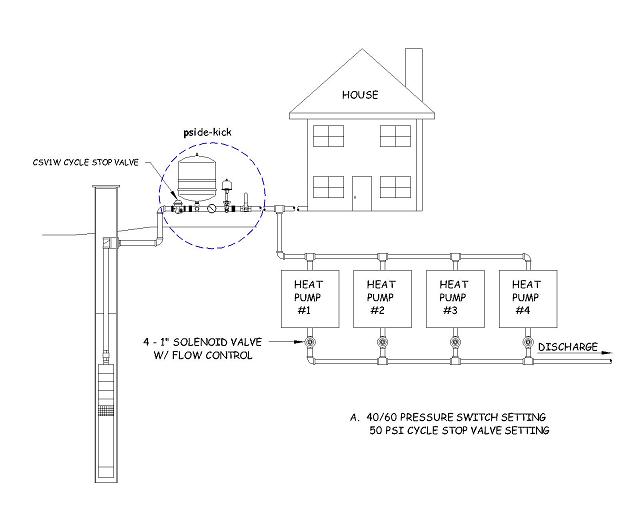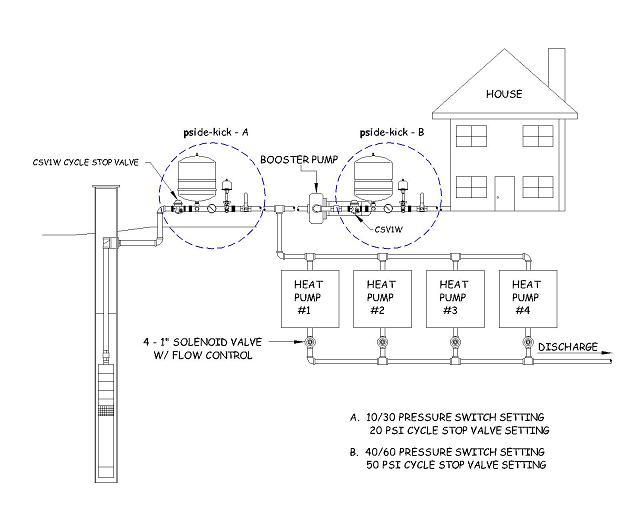To cut pumping cost for a heat pump, a two pump system is recommended. I would use a 25S10-7 pump end, with a 1 HP motor. This pump would deliver 27 GPM at 100' of lift. Control this well pump with a 20 PSI Cycle Stop Valve, a small pressure tank, and a 10/30 pressure switch. After the pressure tank, one line tees off to the heat pump, another tees off to a booster pump for the house. Use about a 3/4 HP jet pump with it's own Cycle Stop Valve set at 50 PSI, and a 40/60 pressure switch.
When the heat pump alone is running, an electric discharge valve opens, the pressure tank drains to 10 PSI, and the pump starts. The 20 PSI CSV will vary the flow to match a single 10 GPM heat pump, two 10 GPM heat pumps, or two 10 GPM heat pumps while still providing up to 10 GPM for the house, which a total of 30 GPM. This should cut your pumping cost by more than 1/2 of what a single 2 HP pump can do. When the heat pump shuts off, the electric discharge valve closes, and the CSV slowly fills the pressure tank to 30 PSI, and the well pump is shut off.
When the house alone is using water, the pressure will drop from 60 to 40 PSI and the 3/4 HP jet pump will start. The 50 PSI CSV will maintain 50 PSI to the house no mater the flow rate being used. This jet pump system is drawing water from the well pump system, so the pressure tank on the well pump system empties as the pressure drops from 30 to 10 PSI, and the well pump is started. The CSV on the well pump feeds exactly as much water to the jet pump booster as the house is using. Both pumps run as long as the house is using water. When the house stops using water, the CSV on the jet pump will slowly fill the pressure tank to 60 PSI, and the jet pump is shut off. Then the CSV on the well pump will slowly fill it's pressure tank to 30 PSI, and the well pump is shut off.
When the heat pump(s) is/are running, the well pump/CSV is delivering 10 or 20 GPM at 20 PSI. If the house needs water at the same time, the jet booster pump comes on, and the CSV on the well pump opens up to supply both the heat pump and the jet booster pump. With a 100' pumping level, you should be able to get 30 GPM total when the house and both heat pumps need water at the same time. When the house no longer needs water, the jet pump system will fill it's pressure tank to 60 PSI, and the jet pump is shut off. Then the CSV on the well pump reduces the flow to 10 or 20 GPM, matching the amount used by the heat pump(s). Again, when both heat pumps are shut off, the well pump fills it's pressure tank to 30 PSI, and both pumps stay shut off until water is needed again.
Reducing the main well pump from a 2 HP to a 1 HP will cut the pumping cost considerably. The only time both pump will run at the same time is when water is being used in the house. The house will use very little water compared to the heat pumps, so the added electric for the booster pump won't add up to much. If the system is also used for irrigation about 500 hours a year, both pumps will run this amount of time.
The 2 HP single pump system with CSV described earlier will use $942.00 per year, or $78.50 per month.
The 2 HP single pump system with VFD described earlier will use $751.00 per year, or $62.58 per month.
The 2 pump system with CSV control described here will use $631.00 per year, or $52.58 per
month.
The 2 pump system will save considerable energy over a single pump system at low flow and high flow conditions. Using CSV controls, these pumps should last a long time, which is what really saves the most energy.

